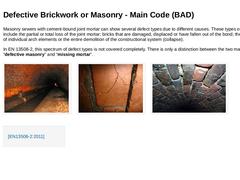
|
Masonry sewers with cement-bound joint mortar can show several defect types due to different causes. These types of defect include the partial or total loss of the joint mortar; bricks that are damaged, displaced or have fallen out of the bond; the breakdown of individual arch elements or the entire demolition of the constructional system (collapse). In EN 13508-2, this spectrum of defect types is not covered completely. There is only a distinction … |
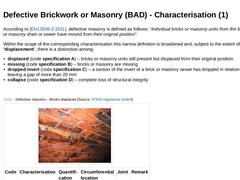
|
According to [EN13508-2:2011], defective masonry is defined as follows: “Individual bricks or masonry units from the fabric of a brick or masonry drain or sewer have moved from their original position”. Within the scope of the corresponding characterisation this narrow definition is broadened and, subject to the extent of the “displacement”, there is a distinction among: -
displaced (code specification A) – bricks or masonry units still present but …
|
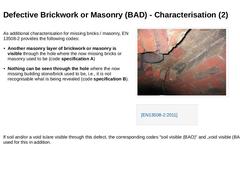
|
As additional characterisation for missing bricks / masonry, EN 13508-2 provides the following codes: (Image: Bricks missing and further … |
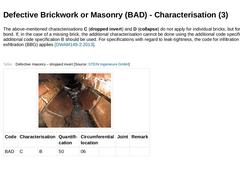
|
The above-mentioned characterisations C (dropped invert) and D (collapse) do not apply for individual bricks, but for the brickwork bond. If, in the case of a missing brick, the additional characterisation cannot be done using the additional code specification A, the additional code specification B should be used. For specifications with regard to leak-tightness, the code for infiltration (BBF) or exfiltration (BBG) applies [DWAM149-2:2013]. (Table: … |
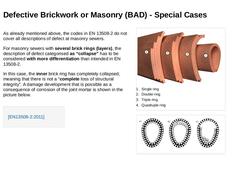
|
As already mentioned above, the codes in EN 13508-2 do not cover all descriptions of defect at masonry sewers. For masonry sewers with several brick rings (layers), the description of defect categorised as “collapse” has to be considered with more differentiation than intended in EN 13508-2. In this case, the inner brick ring has completely collapsed, meaning that there is not a “complete loss of structural integrity”. A damage development that is … |
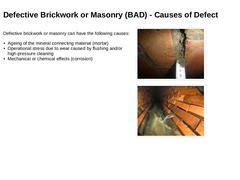
|
Defective brickwork or masonry can have the following causes: -
Ageing of the mineral connecting material (mortar)
-
Operational stress due to wear caused by flushing and/or high-pressure cleaning
-
Mechanical or chemical effects (corrosion)
(Image: Ageing of the mineral connecting material (mortar) - the cement component has corroded over time and only the mineral component remains) (Image: Corrosion of the joint mortar - Leakage - Infiltration (BBF) … |
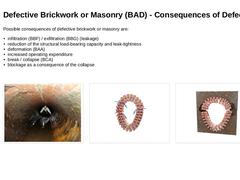
|
Possible consequences of defective brickwork or masonry are: -
infiltration (BBF) / exfiltration (BBG) (leakage)
-
reduction of the structural load-bearing capacity and leak-tightness
-
deformation (BAA)
-
increased operating expenditure
-
break / collapse (BCA)
-
blockage as a consequence of the collapse
(Image: Deformation of a cracked masonry sewer due to soil infiltration caused by leaks) (Image: Deformation of a cracked, masonry sewer due to soil infiltration … |
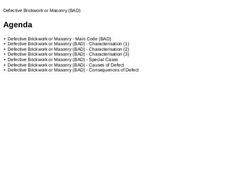
|
|
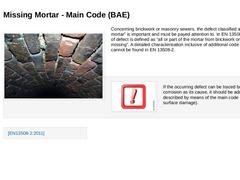
|
(Image: Defective mortar - joint corrosion) Concerning brickwork or masonry sewers, the defect classified as “missing mortar” is important and must be payed attention to. In EN 13508-2, that type of defect is defined as “all or part of the mortar from brickwork or masonry is missing”. A detailed characterisation inclusive of additional code specifications cannot be found in EN 13508-2. Important: If the occurring defect can be traced back to corrosion … |
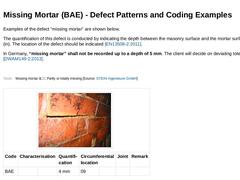
|
Examples of the defect "missing mortar" are shown below. The quantification of this defect is conducted by indicating the depth between the masonry surface and the mortar surface in mm (in). The location of the defect should be indicated [EN13508-2:2011]. In Germany, “missing mortar” shall not be recorded up to a depth of 5 mm. The client will decide on deviating tolerances” [DWAM149-2:2013]. (Table: Missing mortar – Partly missing) (Table: Missing mortar – … |
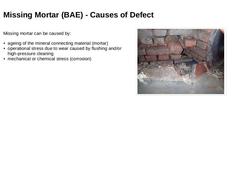
|
Missing mortar can be caused by: -
ageing of the mineral connecting material (mortar)
-
operational stress due to wear caused by flushing and/or high-pressure cleaning
-
mechanical or chemical stress (corrosion)
(Image: Defective Brickwork or Masonry (BAD)) |
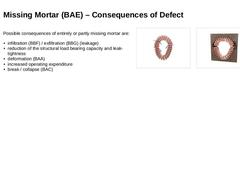
|
Possible consequences of entirely or partly missing mortar are: -
infiltration (BBF) / exfiltration (BBG) (leakage)
-
reduction of the structural load bearing capacity and leak-tightness
-
deformation (BAA)
-
increased operating expenditure
-
break / collapse (BAC)
(Image: Deformation of a cracked, masonry sewer due to soil infiltration as a result of leaks) (Image: Deformation of a cracked, masonry sewer due to soil infiltration as a result of leaks) |
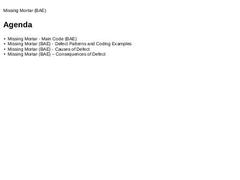
|
|
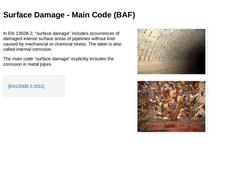
|
In EN 13508-2, “surface damage” includes occurrences of damaged interior surface areas of pipelines without liner caused by mechanical or chemical stress. The latter is also called internal corrosion. The main code “surface damage” explicitly includes the corrosion in metal pipes. (Image: Surface damage in a reinforced concrete channel - Reinforcement visible and corroded) (Image: Surface damage - aggregates protruding ) |
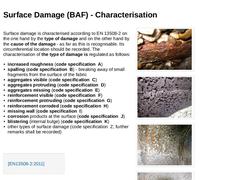
|
Surface damage is characterised according to EN 13508-2 on the one hand by the type of damage and on the other hand by the cause of the damage - as far as this is recognisable. Its circumferential location should be recorded. The characterisation of the type of damage is regulated as follows: -
increased roughness (code specification A)
-
spalling (code specification B) - breaking away of small fragments from the surface of the fabric
-
aggregates visible
|
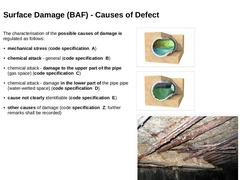
|
The characterisation of the possible causes of damage is regulated as follows: -
mechanical stress (code specification A)
-
chemical attack - general (code specification B)
-
chemical attack - damage to the upper part of the pipe (gas space) (code specification C)
-
chemical attack - damage in the lower part of the pipe pipe (water-wetted space) (code specification D)
-
cause not clearly identifiable (code specification E)
-
other causes of damage (code
|
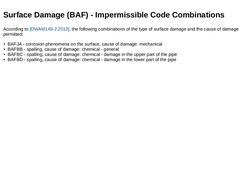
|
According to [DWAM149-2:2013], the following combinations of the type of surface damage and the cause of damage are not permitted: -
BAFJA - corrosion phenomena on the surface, cause of damage: mechanical
-
BAFBB - spalling, cause of damage: chemical - general
-
BAFBC - spalling, cause of damage: chemical - damage in the upper part of the pipe
-
BAFBD - spalling, cause of damage: chemical - damage in the lower part of the pipe
|
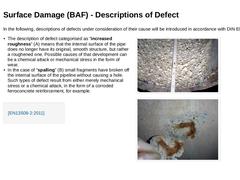
|
In the following, descriptions of defects under consideration of their cause will be introduced in accordance with DIN EN 13508-2. -
The description of defect categorised as “increased roughness” (A) means that the internal surface of the pipe does no longer have its original, smooth structure, but rather a roughened one. Possible causes of that development can be a chemical attack or mechanical stress in the form of wear.
-
In the case of “spalling…
|
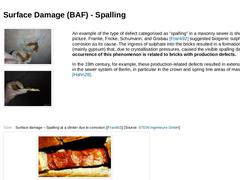
|
(Image: Surface Damage (BAF) - spalling (B)) (Image: Surface damage spalling (B) - Part of concrete spalled off from the inner surface of the pipe due to reinforcement corrosion and low concrete cover) An example of the type of defect categorised as “spalling” in a masonry sewer is shown in the picture. Franke, Fricke, Schumann, and Grabau [Frank92] suggested biogenic sulphuric acid corrosion as its cause. The ingress of sulphate into the bricks resulted … |
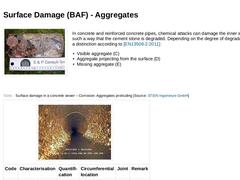
|
(Image: Drill core from a reinforced concrete pipe - The porosity is clearly visible) In concrete and reinforced concrete pipes, chemical attacks can damage the inner surface in such a way that the cement stone is degraded. Depending on the degree of degradation, there is a distinction according to [EN13508-2:2011]: -
Visible aggregate (C)
-
Aggregate projecting from the surface (D)
-
Missing aggregate (E)
(Table: Surface damage in a concrete sewer – … |
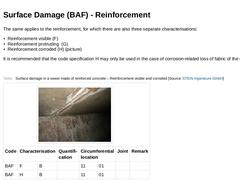
|
The same applies to the reinforcement, for which there are also three separate characterisations: -
Reinforcement visible (F)
-
Reinforcement protruding (G)
-
Reinforcement corroded (H) (picture)
It is recommended that the code specification H may only be used in the case of corrosion-related loss of fabric of the reinforcement. (Table: Surface damage in a sewer made of reinforced concrete – Reinforcement visible and corroded) |
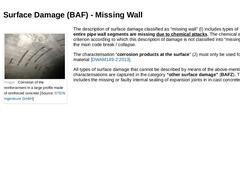
|
(Image: Corrosion of the reinforcement in a large profile made of reinforced concrete) The description of surface damage classified as “missing wall” (I) includes types of defect where entire pipe wall segments are missing due to chemical attacks. The chemical attack is the criterion according to which this description of damage is not classified into “missing parts” and the main code break / collapse. The characterisation “corrosion products at the … |
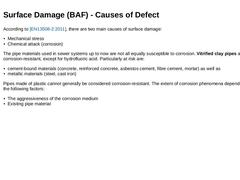
|
According to [EN13508-2:2011], there are two main causes of surface damage: -
Mechanical stress
-
Chemical attack (corrosion)
The pipe materials used in sewer systems up to now are not all equally susceptible to corrosion. Vitrified clay pipes are generally corrosion-resistant, except for hydrofluoric acid. Particularly at risk are: -
cement-bound materials (concrete, reinforced concrete, asbestos cement, fibre cement, mortar) as well as
-
metallic materials (…
|
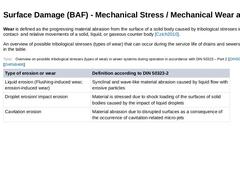
|
Wear is defined as the progressing material abrasion from the surface of a solid body caused by tribological stresses in the form of contact- and relative movements of a solid, liquid, or gaseous counter body [Czich2010]. An overview of possible tribological stresses (types of wear) that can occur during the service life of drains and sewers is illustrated in the table. (Table: Overview on possible tribological stresses (types of wear) in sewer systems … |
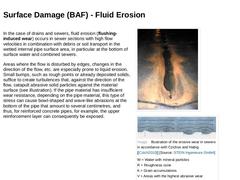
|
In the case of drains and sewers, fluid erosion (flushing-induced wear) occurs in sewer sections with high flow velocities in combination with debris or soil transport in the wetted internal pipe surface area, in particular at the bottom of surface water and combined sewers. Areas where the flow is disturbed by edges, changes in the direction of the flow, etc. are especially prone to liquid erosion. Small bumps, such as rough points or already deposited … |